The top 10 Hot Springs in Iceland that you must visit
It is a challenge to only choose 10 hot springs in Iceland. There are so many, from the ultra-natural bubbling rivers of the geothermal mountains to the man-made heated swimming pools in the manicured city centers.
Though born of different means, all of these hot water experiences are bound by the age-old Icelandic love of swimming comfortably in all seasons, and the incredible gift of this land, the geothermally heated water from deep within the earth. The ones we’ve chosen here represent a variety of access and experience and are spread across the country, making them great stop options on a self-drive adventure.
So throw a few towels in the car, and don’t forget your swimsuit, because there isn’t a meter of this island that doesn’t boast an incredible hot spring or swimming hole.
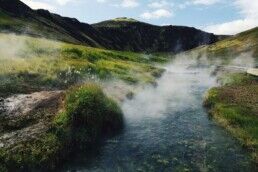
Reykjadalur: A hot river in a steaming valley
Tucked away in the mountains nearby Hveragerði, is this gem of the extinct Hengill volcanic system. A short half-hour drive from Reykjavík (and in the backyard of the Bubbles!), lies this picturesque geothermal river in the colorful southern mountains.
This area is known for its colorful, steamy surroundings, and the many interesting ways that people have learned to live with the active land. (If you stay awhile, you’ll notice all the greenhouses and hear the stories about cooking food buried in the ground! You may even get to try some..)
After venturing forth through the charming town of Hveragerði, you’ll find that there is not only a place to park your vehicle, but also a small coffeehouse where you can inquire about the weather, have a piece of cake, and use the facilities.
To reach the natural hot springs, you must first hike 3km up into the valley, through an endless diorama of far-reaching vistas and tumbling falls. The name of this spring means “Smoky Valley”, and the scenery certainly backs it up.
The beginning of the river hosts a wooden walkway and some basic structures to change behind, but the only bathrooms are at the very beginning of the hike in the parking lot. These pathways have been installed to protect the banks of the river in the most popular bathing spot, where the temperature is milder.
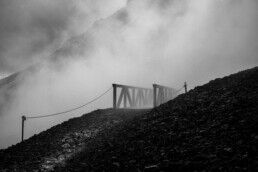
The river is quite long, however, and the further down you go the hotter the water becomes, so make sure to test it before you enter. The earthen banks of the river and the mud at the edges can be surprisingly hot!
Reykjadalur is a favorite among locals and a treasure of the southwestern region. Give yourself ample time to enjoy the hike, explore the area, and to marvel at how quickly the hot waters replenish your tired muscles.
And don’t forget your torch if you are hiking during a darker season. The pathway up can be gravelly in places, and the weather conditions can change quickly.
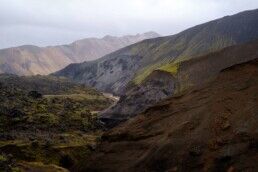
Hveravellir: The highland oasis
Located in a protected nature reserve between two glaciers, Hveravellir is one of our favorite hot springs in Iceland. Hveravellir is a name shared by a gorgeous highland pool, a volcano, and a geothermal field of the Oddnýjarhnjúkur-Langjökull subglacial volcanic system. (So these things are all related pieces of a whole.)
You can reach it by driving the Kjölur Route (F35) into the west highlands- which is an entire adventure in itself! It sits nearly 90km from the wide falls of Gullfoss, and 100km from the nearest petrol station, so a trip to Hveravellir is truly a walk into a wilder world.
Journeying into the highlands can be difficult for an inexperienced driver, but have no fear! There are highland busses that depart for this area if you’d like to be ferried out into the ethereal wilderness by an astute guide. (Which is certainly worth it, because they always have the best stories.)
Formed in 1950 by damming a stream, Hveravellir is a must-stop for hot spring enthusiasts. Similar to many geothermal bathing areas, Hveravellir is characterized by numerous bubbling mud pits, fumaroles, colorful areas of mineral build-up, and various natural hot spring manifestations. Be cautious in areas like these, though.
Not all pools are safe to swim in, and the temperatures of the mud can grow quite high. (There’s even an internet cafe and service center! Check out their live webcam of the area to see what the weather is like before you head out.)
This area connects the north and the south and is one of the few highland paths that will take you straight through. It is an incredible and quiet area to explore and is some of the last true wilderness in Europe.
Popular for trekkers, equestrians, and super jeep enthusiasts alike, this oasis in the highlands truly calls us back to the early days of outlaws hiding from the law in remote glacial caves. Perhaps while you’re out here, soaking in one of the best hot springs in Iceland, you can remember them and the amazing stories they left behind.
Secret Lagoon: The oldest swimming hole in all of Iceland
Locally known as Gamla Laugin, this place began like many of the hot springs in Iceland- a place to do some laundry. (Exciting, no?)
In the late 1800s locals from the nearby town of Flúðir used to venture out to this geothermal area to do their washing up, and eventually to learn to swim! They say that some of the first swimming lessons in Iceland were held here, and these lessons continued on until the late 1940s.
Swimming is such a staple of Icelandic life, that this area was even the site of the legislative body of the Flúðir townspeople once.
These days, the lagoon has been given some extra attention and has been updated a bit from its humble beginnings, but it has not changed too much.
It’s a beautiful spot made better by the care and delicate maintenance of the residents- but you’ll still get the original Icelandic experience here, like the generations before you that so loved these natural hot springs.
These days, there’s a small changing and shower area, and even a tiny bistro serving snacks and drinks! There is a walking path around the pool itself, to give visitors a chance to view the spring in action and actually see where the hot water that feeds the natural hot springs is coming from.
The bubbling waters creep out from various places throughout the Hverahólmi geothermal area, and the hot steam protects the lush moss and vegetation.
These waters also feed geysers, and they circulate themselves within a mere 24 hours- so you know you’re getting a fresh start every day. All of this water is fed into the lagoon naturally, and it stays at around 39°C year-round, so you can visit for a dip regardless of the season you travel in.
(And trust us, there are few things more magical than unwinding in a natural hot spring while the glistening snow piles up all around. Except of course running off to a cozy Bubble for a post-spring snooze. Best sleep you can imagine!)
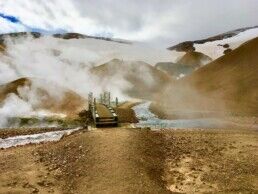
Kerlingarfjöll: Bathe among the trolls!
Named “Old lady mountains”, this highland mountain range tells a tale of an old female troll that went wandering and stayed out a bit too long, which of course spelled her doom. As we’re sure you know, trolls can’t wander under the light of day, and so any troll that feels the rays of the sun instantly turns to stone.
Haven’t you noticed the strange rock stacks and faces in the mountains? Keep an eye out on your journeys here, and you might yet spy an unlucky wayward troll. (The rest of them have gotten the picture, and are well hidden.)
We can imagine that she must have been overwhelmed by the beauty of the place, much as we are! This 10,000-year-old mountain range was formed by volcanic activity way back in the heyday of the trolls and remains a coveted destination because of its rainbow rhyolite mountains, steaming geothermal areas, and incredible lonely vistas.
Hikers love this region for its beauty and remote peace, and snowmobilers love it in the winter for its endless slopes and great powder. (We love it for its natural hot springs!)
Much like Hveravellir, this location is also reachable by traveling the Kjölur or Kjalvegur Route. A 4×4 is recommended for unpaved F road treks like these, but special public transport can get you here as well. And if you’re a winter traveler, we highly suggest joining a tour with an experienced guide.
PLAN YOUR JOURNEY
Travelling to Iceland?
Check our overnight tours with a driver guide that includes a one night stay in a bubble.*Starting from ISK 74.900 per person
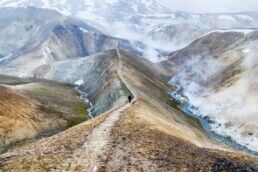
The highlands are their very own planet, so the weather conditions are best interpreted by someone with a few seasons under their belt.
In the summer, however, the highlands open up with mostly clear roads and their colors on full display. Though keep an eye out, you are likely to still find some snow in the mountains even during the height of July. You are, after all, journeying into one of our most magical areas.
There is accommodation and food to be found out here if you can believe it, and a mere 20-minute walk from there lies the Kerlingarfjöll hot spring. A flowing river much like Reykjadalur, you will hike upstream on a marked trail to find a choice spot here, and you will likely have the area mostly to yourself.
You are after all bathing in one of the best hot springs in Iceland, and in all of troll country combined. A rare treat for the intrepid traveler!
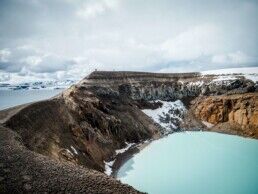
The Víti Crater Lake in Askja: Swimming in the mouth of a sleeping giant
No hot spring list would be complete without the addition of a swimming hole inside an actual volcano crater. Askja is a central highland favorite near the Dyngjufjöll mountains, which is easiest to access via guided tour, but it’s big enough that if you’re driving you are very unlikely to miss it.
In fact, its very name means “box” or “caldera” in Icelandic. This one is certainly a bucket list item for many, and one of the most unusual of the hot springs in Iceland.
Only safely accessible during certain months of the year- Askja has not erupted since 1961. Known for its larger eruption in 1875 that set off a wave of Icelandic emigration, Askja sent ash all over the countryside- and the wind carried it as far as Poland. This is an intensely studied place, however, and it is safe to visit.
Like all areas of geothermal activity, conditions may change at any time and are closely monitored. Depending on the situation at the time of your visit, it may or may not be possible to swim in the crater. It’s always good to check on these things in places like safetravel.is.
To reach the crater, you’ll find yourself trekking through places of year-round snow, colorful lava fields, and many geological reminders of how alive the earth underneath your feet once was, and still may be.
Wondrous though these sights are, they pale in comparison to the milky blue lake at the bottom of the caldera. If the weather is fair, you can attempt the path down into the crater to bathe in the 24°C sulfuric waters. There are no facilities out here, so don’t forget your towels!
Though Askja sleeps for now, you can spin and float in her opaque teal waters and know that she yet lives, bubbling away far under the earth. A swim truly unlike any other.
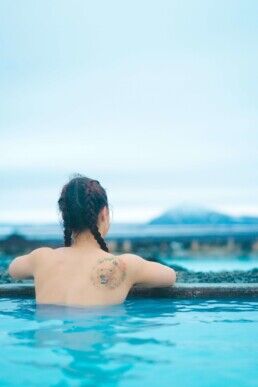
Mývatn Nature Baths: The north country’s favorite lagoon
Like milky blue Askja, the nearby neighbor Mývatn Nature Baths also boasts mineral-rich colorful water- and it’s one of our all-time favorite stops on a self-drive. Situated in a highly geothermal area, the Mývatn region is an incredible place to explore, and a part of the new “Diamond Circle”.
An area of vivid colors, fumaroles, gorgeous endless lakes, and thundering inland waterfalls, this area of Iceland is certainly one to have on your list.
You may even recognize some areas from popular film and television shows, or from popular Icelandic legends. With place names like Dimmuborgir and Drekagil, you can imagine what sorts of dragons must have passed through this place to create the scorched earth and stacks of lava that form it.
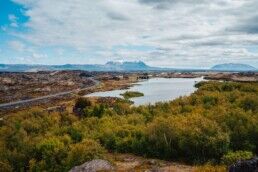
Located conveniently in a designated nature reserve, the Mývatn Nature baths are perfect for those that would rather not hike vertically up a rocky pass to change in the wild. Right off the main paved road, not only do they have a luxurious changing facility and shower area, but they also have a restaurant, facilities for families, and two steam baths.
Unlike the wild hot springs, there is a cost of admission for this experience. These facilities are accessible year-round, and the water is guaranteed to be between 36°C-40°C regardless of the season. The water that fills the lagoon is drawn from nearly 2,500 meters down and is said to be beneficial for a variety of skin ailments due to the high mineral content.
An excellent place to relax and luxuriate, Mývatn is certainly our northern pick for a no-fuss getaway in the middle of some of the most delicate nature that Iceland has to offer.
Landmannalaugar: “The People’s Pool”
Another of the highland natural hot springs, Landmannalaugar is the name of a popular multi-day hiking route in the Fjallabak Nature Reserve of the southern highlands. Known as the gateway for those that want to hike to Þórsmörk in the south, one absolutely must visit to understand the true scale and color of the place that has come to be known as Thor’s valley.
Like a few other geothermal areas, this is another well-known area of colorful rhyolite mountains. Multiple natural hot springs come together to form the warm brook where visitors can bathe. Named “The People’s Pool”, Landmannalaugar primarily draws hikers on their way through the popular summer trek of the same name, and is a true balm to weary muscles.
With waters that can reach up to 40ºC, it is advisable to check the ground before you take off your shoes as the mud can get quite hot in certain areas. The heat is not always evenly distributed, so it pays to be cautious. Especially if you need those feet to hike home!
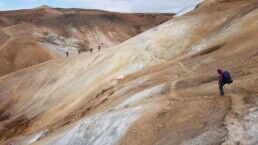
Though Landmannalaugar is located in the sweet spot of the remote Iceland wilderness, there are actually some shelter and showering facilities to be found. The local custom before bathing (be it a city pool or a wild natural hot spring), is to completely shower before entering, when possible.
Of course in some circumstances, there are no facilities, and the custom takes a back seat. But do remember that these are wonders that are loved by many, and so it is expected that you keep the area neat and remove any trash or waste that you may create while visiting.
There are a few different hot springs here that create a natural brook, and because of the delicate ecosystem, it is recommended to use the wooden pathways when walking here. And no matter how dirty you may be after that hike- don’t forget to leave your soap in the showers!
The hot springs are a natural treasure, and we would like to keep them that way for all who wander to enjoy them. May The People’s Pool always remain as such, a pristine hideaway in the rainbow mountains of our diverse highland paradise.
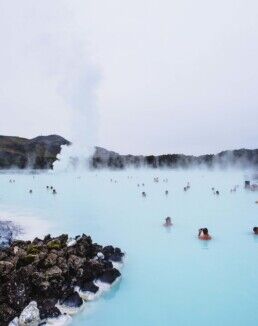
Blue Lagoon: One of National Geographic’s 25 wonders of the world
It would be a massive oversight to complete a list about hot springs in Iceland without mentioning the most famous of them all, the breathtaking Blue Lagoon. The story of the Blue Lagoon begins in the ’80s when local residents started to bathe in the reservoir formed at the Svartsengi geothermal power plant nearby.
The water that came up from the deep chasms of the earth was milky blue and mineral-rich, and people started to notice that bathing in the geothermal seawater had many health benefits- aside from just being a good time. The Blue Lagoon became a topic of much study, and remains so today through their Research and Development center.
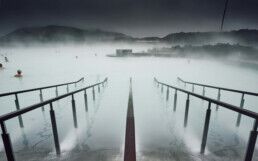
Eventually, the Blue Lagoon we know and love was formed. It has been updated a few times since those halcyon days, but remains true to the mysterious pool of sky blue wonder that it always was.
Located in the Reykjanes peninsula in between the Keflavik airport and our brand new live volcano, the Blue Lagoon is easy to access and sits right at the doorstep of a whole region of awe-inspiring exploration and protected geothermal areas.
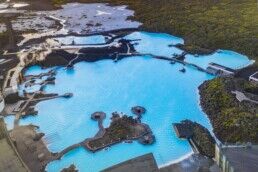
Access to the Blue Lagoon does require paid admission, and this process happens by way of package selection, so that you can choose the lagoon experience you are the most interested in having.
Whether that be a dip and a jaunt through the moss field, or a fluffy bathrobe and private floating water massage affair, there are a multitude of choices there for you.
You can hang out in the stone grotto, or swim up to your neck while the crisp Icelandic wind kisses your face, or get a drink at one of the watering holes in the lagoon. (Big fan of the skyr smoothies, myself.)
Try out the silica and algae masks that the lagoon is famous for and grab a first-class meal in your bathrobe at the LAVA restaurant on your way out! Blue Lagoon has something for everyone, and it’s a gorgeous place to visit.

Seljavallalaug: the hot spring in the mountains
Often called one of Iceland’s oldest pools, (and sometimes confused with the Secret Lagoon for this reason) Seljavallalaug is a bit more traditionally shaped than some of the more natural hot springs on our list. Located near Seljavellir and Skógafoss on the south coast, this is a fairly straightforward stop as far as hot springs in Iceland go.
Fed by a geothermal hot spring like the others, Seljavallalaug has a border built around it that joins it to the mountain. This gives it a more man-made appearance in some respects, which the border wall itself of course is. But the natural hot spring is a gift of Iceland alone. (And the mountain that makes up one entire side of it!)
Though there are some small changing rooms on-site, there are no facilities or shops at the location itself. This is a wild place on private land that is graciously open to the public, and it is good to note that there are no lifeguards on duty, and the road is only partially paved.
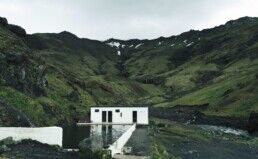
There’s a short walk from the parking spot to the actual pool, but it is open 24 hours a day and there’s no admission to take a dip. The pool is constantly fed by the spring, and so the water cycles out on its own- maybe even slightly filtered or enhanced by the bright green algae and the remaining ash from nearby Eyjafjallajökull. But tucked away in the embrace of the mountains like it is, with a fresh mist hanging softly above it, it truly does feel like a place from a dream.
A magical place for a northern lights soak or a midnight sun dive, Seljavallalaug is a historical slice of old Iceland waiting for you in the great southern mountains below the glaciers. A pool that taught many locals how to brave the waters at sea, this is a great spot for a serene photo, or just a calm unwind at the end of a long day. (Or both!)
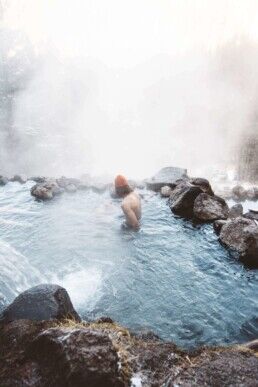
Landbrotalaug: Journey to the center of...Snaefellsnes!
This old favorite of ours is located on the scenic peninsula of Snaefellsnes, just two hours north of Reykjavík, and hosts two of the most romantic and remote hot springs yet. In the back fields of a long-abandoned farm, there are two small hot pots bubbling and waiting for you amongst the memory of residents past.
You’ll know you’re in the right place once you’ve found the farm “Skalg” sitting high and lonely on a hill after passing the Eldborg crater on the left. They’ve even gone and put up a sign for you, reading “HEIT LAUG” or “HOT SPRING”. You can leave your vehicle after this point and walk on down to find the pools.
When you find one, you’ll notice that there is a pond separating them, and you’ve got your choice of walking around it, or going straight through it on a tiny path of rocks placed by an intrepid adventurer before you. (I would walk around, but I’m a fan of sturdy pathways and dry socks.)
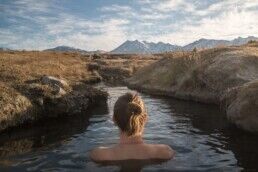
The first hot spring is fed by a pipe and is fairly shallow. The other is deep enough to cover you likely to your chest or neck and is the warmer of the two.
Though this is fairly unchallenging terrain, it is also rocky- so use caution while traversing the paths to the hot springs, as there are few places out here to go for first aid. (There are also no changing facilities out this way, so like many of the more remote hot springs in Iceland, you’ll have to come dressed or get creative out in the open air. At least you’ve got a nice warm hot spring waiting on you!)
The warmer and deeper of the two hot pots is just barely hidden by a small rock wall, which helps a bit with the possible wind, and of course, with the privacy.
Hopefully, you’ll be able to grab a moment alone, and maybe some northern lights if you’re here at the right time. This is a small little pool, perfect for the kind of quality time you might be looking for if you’ve brought someone special with you. Don’t worry- you can always take it back to the Bubble later.
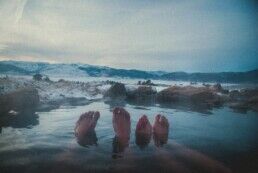
Where the hot springs flow
This of course is not an exhaustive list of the hot springs in Iceland. Because of the nature of this volcanically formed and seismically manipulated landscape, new natural details are being revealed and created all the time.
The hot springs that you have loved the most on your past visits are always susceptible to change, and so every chance that you have to take a dip is worth the effort.
Beyond this, there are heated pools in nearly every town, and geothermal spas throughout the countryside with uniquely shaped baths and even barrels of heated beer that you can dive into!
Let us know what some of your favorite hot springs are, or what you’d like to hear about next!
PLAN YOUR JOURNEY
Travelling to Iceland?
Check our overnight tours with a driver guide that includes a one night stay in a bubble.*Starting from ISK 74.900 per person